 |
|||
|
Computer-generated
perspective view of the 26 kilometre wide Pwyll impact crater.
|
|||
| THE CRATERS OF EUROPA | |||
| Prior to the Galileo mission there were just three known craters on Europa. These were between 18 and 25 kilometres wide. One appeared to be bowl shaped, another shallow and degraded, and the largest a small multi-ringed impact basin. In Voyager images, the few craters that could be seen were very indistinct. It was uncertain how many, or indeed if any of the dark maculae were caused by impacts. A bright spot at the centre of one macula suggested a cratering origin. Melting at the point of impact appeared to have created an icy surface, free of debris. | |||
| Galileo images have revealed more craters, bringing the number of known craters on Europa's surface to 28. The craters are small and very spread out. Some regions have a slightly greater density of craters than others, indicating that these surfaces are older. | |||
| It has been suggested that the lack of craters on Europa is because the surface is too soft to retain impressions. The ice flows back towards the surface like a glacier and after a time the crater disappears completely. In which case the surface of Europa might be quite old but just looks young. The sparse crater population of Europa is normally taken to imply that the surface is somewhere between 10 and 100 million years old and extremely young in terms of planetary history. It would also suggest that even if Europa is not currently active it has at least been active very recently. | |||
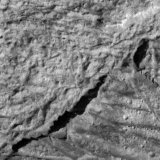 Conamara Chaos region - small secondary craters from Pwyll . |
|||
| The cratering rates or flux near Jupiter during the early history of the Solar System was a lot lower than elsewhere. This makes it difficult to give accurate ages for surfaces in different parts of the Solar System, including Europa. | |||
| Pwyll | |||
| A 26 kilometres diameter crater was discovered by the Galileo probe. It was named "Pwyll", after the Celtic god of the underworld. The impact excavated light coloured debris, ejecting it outwards over the surrounding terrain. Ejecta from the crater has been thrown over a thousand kilometres from the impact site. In common with craters previously identified, the immediate surroundings are dark. The crater has a sharp rim and a complex peak at its centre. The peak gives the appearance of having formed from rock rather than ice, but this is because ice at very low temperatures behaves just like rock. | |||
 Bright ejecta rays from Pwyll crater. |
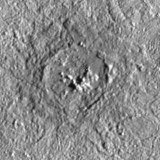 Close-up view of central Pwyll. |
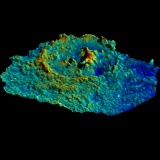 Computer-generated perspective view of Pwyll . |
|
| Although the Pwyll impact event threw brighter material across the Europan landscape, the crater itself consists of material darker than the immediate surroundings. The incoming asteroid or comet seems to have penetrated the crust, thereby releasing material from deeper within Europa. The fact that this material is darker implies that there are sub-surface layers, at a depth of a few kilometres, that are mineral rich. If so, this would also account for the dark material found in Europa's triple bands. The structure of the centre of Pwyll is similar to terrestrial icebergs. The centre of Pwyll is therefore very strong evidence for the existence of a deeper layer of slush or liquid water, if not a whole ocean. | |||
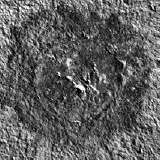 Pwyll's darker mineral-rich material. |
|||
| Tyre | |||
| Tyre is a multi-ringed impact crater with a diameter of 140 kilometres. The low relief of this crater suggests that it is a good example of ice flow slowly obliterating craters. However, an alternative theory proposes that an impact onto a thin brittle crust causes the crater to collapse very quickly. This method too would leave a very flat crater relief. Tyre's ring structure lies on top of older linear features. Some triple bands and bright bands cut across Tyre, showing that they are younger than the crater. This demonstrates that forces have modified the crust both before and after the impact event. | |||
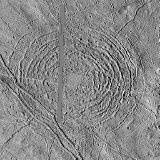 Wide-angle Galileo view of Tyre crater. |
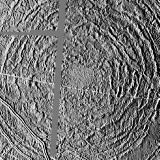 The multi-ringed structure of Tyre crater. |
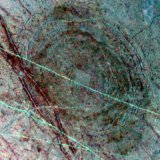 Varying surface chemistry across the Tyre region. |
|
| The surface chemistry of the Tyre region can be seen when near-infrared imagery is combined with colour imagery. Where the surface is richer in various mineral salts the image appears blue. Yellow and orange colours occur where the surface is dominated by ice. The very centre of Tyre appears to be composed of ice with coarser grains. | |||
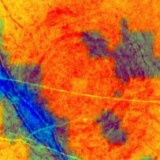 Colour and near-infrared composite of the Tyre region. |
|||
| Manann'an | |||
| The impact crater Manann'an (named after the Irish god of the sea) is 30 kilometres in diameter, and, like Pwyll, has scattered bright material over distances of hundreds of kilometres. Again, like Pwyll, the crater itself is darker then the surrounding terrain, further evidence of deeper minerals. | |||
| Cilix | |||
| The Cilix impact crater is 20 kilometres across, with rims up to 500 metres tall. The central mountain is as high as the rim. Cilix crater conforms to the 'traditional' shape of craters, with a flat floor, central peak and raised rims. A theory to account for this is that the incoming impactor failed to penetrate the crust. Perhaps the incoming speed was too low, or the crust too thick. Either way, there was a failure to reach deeper levels of slush or water, and the crater was not subsequently filled. | |||
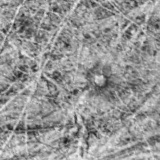 Wide-angle view of Cilix impact crater. |
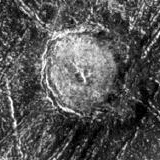 Close-up view of Cilix structure. |
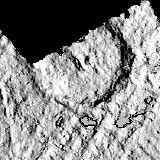 Artificially computer-shaded view of Cilix topography. |
|
|
|
|||